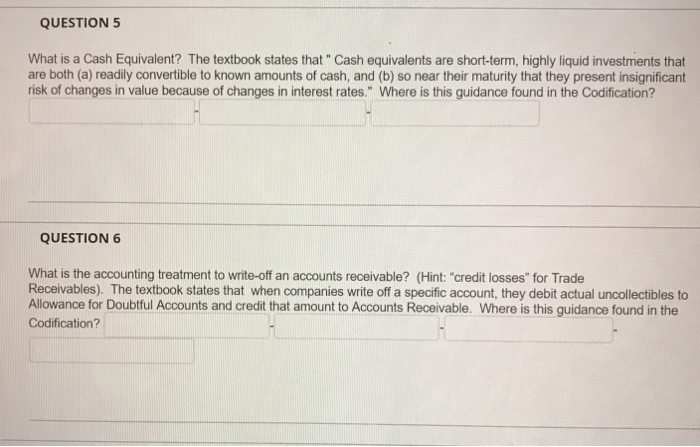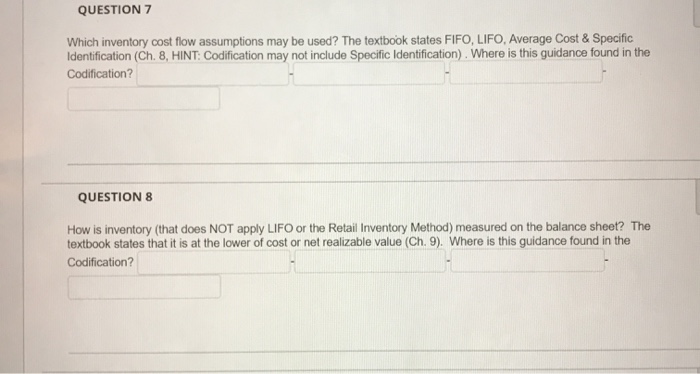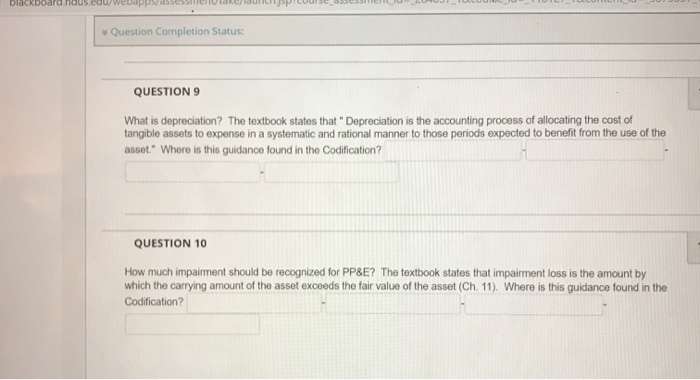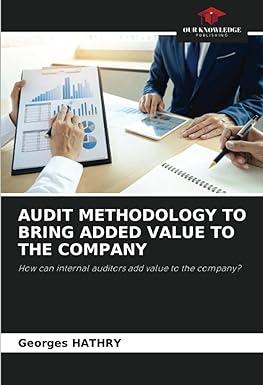QUESTION 5 What is a Cash Equivalent? The textbook states that "Cash equivalents are short-term, highly liquid investments that are both (a) readily convertible to known amounts of cash, and (b) so near their maturity that they present insignificant risk of changes in value because of changes in interest rates." Where is this guidance found in the Codification? QUESTION 6 What is the accounting treatment to write-off an accounts receivable? (Hint: "credit losses" for Trade Receivables). The textbook states that when companies write off a specific account, they debit actual uncollectibles to Allowance for Doubtful Accounts and credit that amount to Accounts Receivable. Where is this guidance found in the Codification? QUESTION 7 Which inventory cost flow assumptions may be used? The textbook states FIFO, LIFO, Average Cost & Specific Identification (Ch. 8, HINT: Codification may not include Specific Identification). Where is this guidance found in the Codification? QUESTION 8 How is inventory (that does NOT apply LIFO or the Retail Inventory Method) measured on the balance sheet? The textbook states that it is at the lower of cost or net realizable value (Ch. 9). Where is this guidance found in the Codification? blackboard.ndus.edu/weudpud SesLTURU CUSE U LUNUT TIL TOCOMLIJUNJOJ Question Completion Status: QUESTION 9 What is depreciation? The textbook states that "Depreciation is the accounting process of allocating the cost of tangible assets to expense in a systematic and rational manner to those periods expected to benefit from the use of the asset." Where is this guidance found in the Codification? QUESTION 10 How much impairment should be recognized for PP&E? The textbook states that impairment loss is the amount by which the carrying amount of the asset exceeds the fair value of the asset (Ch. 11). Where is this guidance found in the Codification? QUESTION 5 What is a Cash Equivalent? The textbook states that "Cash equivalents are short-term, highly liquid investments that are both (a) readily convertible to known amounts of cash, and (b) so near their maturity that they present insignificant risk of changes in value because of changes in interest rates." Where is this guidance found in the Codification? QUESTION 6 What is the accounting treatment to write-off an accounts receivable? (Hint: "credit losses" for Trade Receivables). The textbook states that when companies write off a specific account, they debit actual uncollectibles to Allowance for Doubtful Accounts and credit that amount to Accounts Receivable. Where is this guidance found in the Codification? QUESTION 7 Which inventory cost flow assumptions may be used? The textbook states FIFO, LIFO, Average Cost & Specific Identification (Ch. 8, HINT: Codification may not include Specific Identification). Where is this guidance found in the Codification? QUESTION 8 How is inventory (that does NOT apply LIFO or the Retail Inventory Method) measured on the balance sheet? The textbook states that it is at the lower of cost or net realizable value (Ch. 9). Where is this guidance found in the Codification? blackboard.ndus.edu/weudpud SesLTURU CUSE U LUNUT TIL TOCOMLIJUNJOJ Question Completion Status: QUESTION 9 What is depreciation? The textbook states that "Depreciation is the accounting process of allocating the cost of tangible assets to expense in a systematic and rational manner to those periods expected to benefit from the use of the asset." Where is this guidance found in the Codification? QUESTION 10 How much impairment should be recognized for PP&E? The textbook states that impairment loss is the amount by which the carrying amount of the asset exceeds the fair value of the asset (Ch. 11). Where is this guidance found in the Codification









